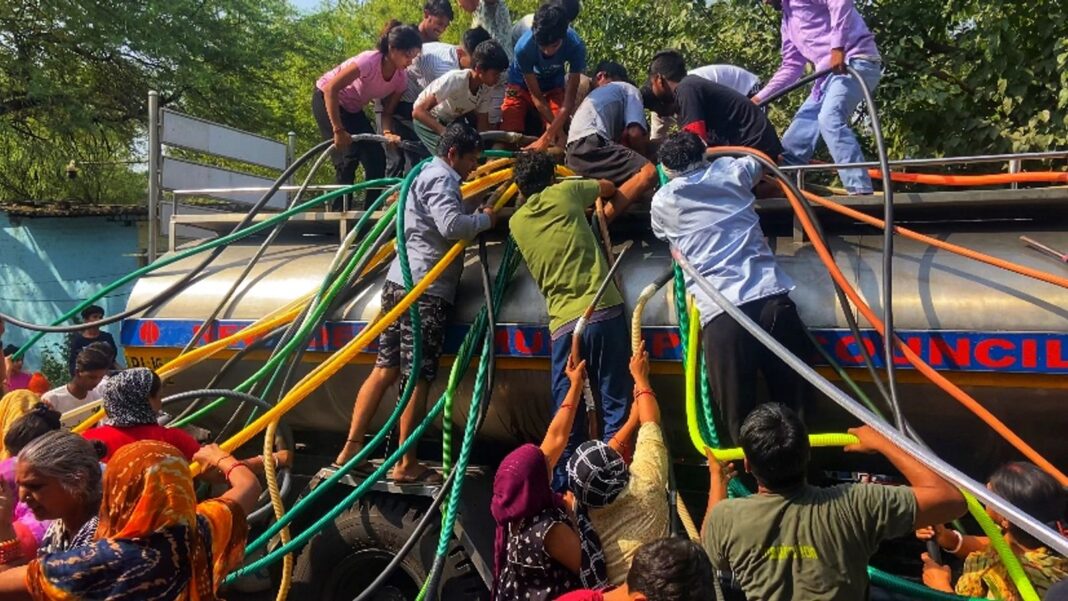Manisha has been waiting for hours in the scorching heat for the water tanker.
Hundreds of residents like her from the Vivekanand camp have lined up their empty container along the sidewalk with hose pipes.
While the tanker is rolling into this narrow lane young boys and girls climb atop the moving vehicle. A dozen are there even before the tanker stops.
They insert the pipes and the process to draw out every precious drop begins. There is chaos as women try and fill up every empty container before the water runs out.
“We wait for hours standing in line hungry and thirsty,” the 32-year-old tells Sky News. “We have to bring our babies here in the heat and wait.”
Pushpa says: “Sometimes the tanker can take three to four hours and sometimes doesn’t come at all. Should we fill water or work?
“There has to be one family member around to fill water, only then we will get water.”
Pratima joins in: “We can’t cook or do household chores till we fill water. We leave our young children at home and wait here.”
There is no running water in the few hundred homes in the Vivekanand camp nestled around the affluent diplomatic enclave of the national capital Delhi.
The camp is a stark contrast to the beautiful grounds and lush manicured lawns that surround the many embassies.
Its visuals represent the glaring inequalities and contradictions that exist here in India.
This has been going on for years, but this time the problem is greater as temperatures are reaching record levels.
Read more:
Temperature hits 52C as Dehli suffers hottest day on record

Holding a child in her lap, Kamla Devi says: “We can go hungry but without water we cannot survive. There are fights and arguments over water.”
There are some days this lifeline does not show up and buying water is not an option for many. Families complain of the quality of the water they get.
Priyanka says: “Once we found a dead rat and a slipper inside the tanker, this water is unfit to drink. Our children get sick often.”
Pushpa echoes the same sentiment: “Sometimes the water is dirty and smells, but we are helpless and have no choice as there is no other source for us.”
India is reeling under an intense heatwave not seen in decades. Record temperatures have been noted in many places crossing 50C (122F).
But the difference this time being, that these heatwave conditions are lasting for prolonged periods of time. We are in the middle of the summer season and there are still many weeks to go.

Around 200 people are reported to have died due to heat stroke across the country. The Indian Metrological Department have announced red alerts in most parts of Northern India. Schools have been closed early in anticipation of the heat.
In the national capital, Delhi average temperatures have been above 45C for weeks. The electric grid is overwhelmed with power shortages making life even more difficult in this searing heat.
Experts believe that post El Niño warming has contributed to higher-than-usual temperatures in north India this year.
The continental dry air that blows over a large land mass affects the weather in the north. And since Delhi is far away from large bodies of water it is severely impacted by this.
The Urban Heat Island (UHI) effects are a contributing factor to high temperatures in large cities like Delhi. Densely packed buildings lack proper airflow and concrete, brick and mortar structures retain heat and do not allow the cooling process at night. A lack of tree cover is also another reason.
Over the years weather patterns have changed and the intensity of floods, forest fires, and droughts have increased some scientist attributing this to climate change.

Dr Naresh Kumar, a senior scientist at the Indian Metrological Department told Sky News: “If you see the long-term data anywhere, all over the globe temperatures are increasing, heatwave days are increasing and that is true for India too.”
Water shortage and scarcity is a serious concern especially in metropolitan cities. As a result of the dry spells, reservoirs and water channels are drying up and that is having a devastating effect on farming. Production of food and cash crops is falling drastically.
A number of dams in Maharashtra, Madhya Pradesh and Telangana are reported to be below 40% of their storage capacity and is a cause of concern.
For many, working under this blistering heat is the only option to livelihood.
Read more:
Has India’s economy floundered under Modi?
Deepfakes and influencers in India’s ‘digital election’

Keep up with all the latest news from the UK and around the world by following Sky News
Anil Kumar is paid 500 rupees (£5) working at a construction site. He spends most of his eight hours digging and drilling rock under the sun.
He tells Sky News: “It’s extremely hot but for us labourers there’s no option, we have to earn a living for our children and families. We have to go and work even when its so hot.”
India is in the midst of a general election. The government is yet to come up with a heat action plan to bring any relief for its citizens.
Prime Minister Narendra Modi had a meeting with concerned department officials on Sunday and reviewed the situation on the ongoing heatwave.







